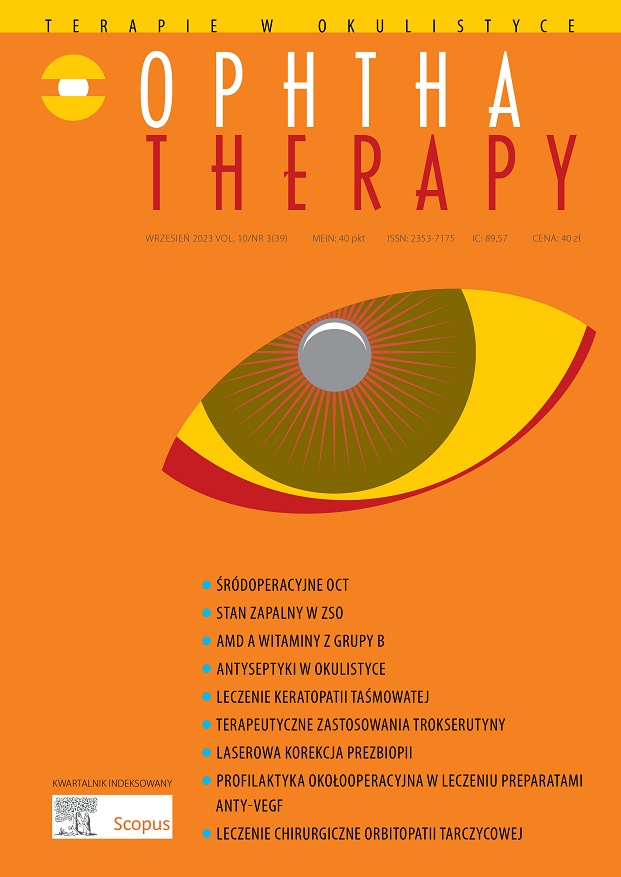Influence of laser correction of presbyopia using the Presbyond® Laser Blended Vision (LBV) method on the stereopsis Review article
Main Article Content
Abstract
Presbyond® Laser Blended Vision (LBV) method involves the non-linear aspheric ablation of the cornea with controlled induction of spherical aberrations in both eyes and the induction of micromonovision of -0.75 to -1.50 D in the non-dominant eye. The article presents the results of published studies analyzing the effect of laser correction of presbyopia using the Presbyond® LBV method on the stereopsis. The studies published so far indicate that the Presbyond® LBV treatment allows for maintaining functional postoperative stereoscopy, achieving patient satisfaction and independence from glasses.
Downloads
Article Details

This work is licensed under a Creative Commons Attribution-NonCommercial-NoDerivatives 4.0 International License.
Copyright: © Medical Education sp. z o.o. License allowing third parties to copy and redistribute the material in any medium or format and to remix, transform, and build upon the material, provided the original work is properly cited and states its license.
Address reprint requests to: Medical Education, Marcin Kuźma (marcin.kuzma@mededu.pl)
References
2. Reinstein DZ, Couch DG, Archer TJ. LASIK for hyperopic astigmatism and presbyopia using micro-monovision with the Carl Zeiss Meditec MEL80 platform. J Refract Surg. 2009; 25: 37-58. http://doi.org/10.3928/1081597X-20090101-07.
3. Reinstein DZ, Archer TJ, Gobbe M. LASIK for Myopic Astigmatism and Presbyopia Using Non-Linear Aspheric Micro-Monovision with the Carl Zeiss Meditec MEL 80 Platform. J Refract Surg. 2011; 27: 23-37.
4. Reinstein DZ, Carp GI, Archer TJ et al. LASIK for presbyopia correction in emmetropic patients using aspheric ablation profiles and a micro-monovision protocol with the Carl Zeiss Meditec MEL 80 and VisuMax. J Refract Surg. 2012; 28: 531-41. http://doi.org/10.3928/1081597X-20120723-01.
5. Uthoff D, Pölzl M, Hepper D et al. A new method of cornea modulation with excimer laser for simultaneous correction of presbyopia and ametropia. Graefes Arch Clin Exp Ophthalmol. 2012; 250: 1649-61. http://doi.org/10.1007/s00417-012-1948-1.
6. Pinelli R, Ortiz D, Simonetto A et al. Correction of presbyopia in hyperopia with a center-distance, paracentral-near technique using the Technolas 217z platform. J Refract Surg. 2008; 24: 494-500. http://doi.org/10.3928/1081597X-20080501-07.
7. Castro JJ, Ortiz C, Jiménez JR et al. Stereopsis Simulating Small-Aperture Corneal Inlay and Monovision Conditions. J Refract Surg. 2018; 34(7): 482-8. http://doi.org/10.3928/1081597X-20180517-01.
8. Garcia-Gonzalez, Teus MA, Hernandez-Verdejo JL. Visual outcomes of LASIK-induced monovision in myopic patients with presbyopia. Am J Ophthalmol. 2010; 150: 381-6. http://doi.org/10.1016/j.ajo.2010.03.022.
9. Aarcon A, Anera RG, Villa C et al. Visual quality after monovision correction by laser in situ keratomileusis in presbyopic patients. J Cataract Refract Surg. 2011; 37: 1629-35.
10. Fawcett SL, Herman WK, Alfieri CD et al. Stereoacuity and Foveal Fusion in Adults with Long-standing Surgical Monovision. J AAPOS. 2001; 5: 342-7. http://doi.org/10.1067/mpa.2001.119785.
11. Reinstein DZ, Archer TJ, Gobba M. Aspheric ablation profile to presbyopic corneal treatment using the MEL 80 and CRS Master Laser Blended Vision module. J Emmetropia. 2011; 2: 161-75.
12. Datta S, Foss AJ, Grainge MJ et al. The importance of acuity, stereopsis, and contrast sensitivity for health-related quality of life in elderly women with cataracts. Invest Ophthalmol Vis Sci. 2008; 49: 1-6. http://doi.org/10.1167/iovs.06-1073.
13. Ohlsson J, Villarreal G, Abrahamsson M et al. Screening merits of the Lang II, Frisby, Randot, Titmus and TNO stereo tests. J AAPPOS. 2001; 5: 316-22.
14. O’Connor AR, Birch EE, Anderson S et al.; FSOS Research Group. The Functional Significance of Stereopsis. Invest Ophthalmol Vis Sci. 2010; 51: 2019-23.
15. Zhang T, Sun Y, Weng S et al. Aspheric Micro-monovision LASIK in Correction of Presbyopia and Myopic Astigmatism: Early Clinical Outcomes in a Chinese Population. J Refract Surg. 2016; 32: 680-5. http://doi.org/10.3928/1081597X-20160628-01.
16. Brar S, Sute SS, Bagare SN et al. Functional Outcomes and Reading Speeds following PRESBYOND LBV Using Nonlinear Aspheric Ablation Profiles Combined with Micro-Monovision. J Ophthalmol. 2021; 2021: 2957443. http://doi.org/10.1155/2021/2957443.
17. Romero M, Castillo A, Carmona D et al. Visual quality after presbyopia correction with excimer laser ablation using micromonovision and modulation of spherical aberration. J Cataract Refract Surg. 2019; 45: 457-64. http://doi.org/10.1016/j.jcrs.2018.10.048.
18. Russo A, Reinstein DZ, Filini O et al. Visual and Refractive Outcomes Following Laser Blended Vision With Non-linear Aspheric Micro-anisometropia (PRESBYOND) in Myopic and Hyperopic Patients. J Refract Surg. 2022; 38: 288-97. http://doi.org/10.3928/1081597X-20220323-01.

